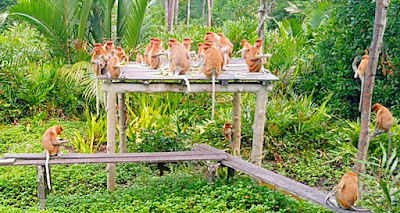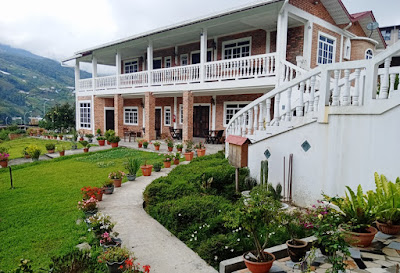A Sanctuary for the Proboscis of Borneo
 |
| Proboscis Feeding time |
The Labuk Bay Proboscis Monkey Sanctuary in
Sandakan is a place where you don’t need to walk like the fictional pink
panther in the forest to sight these arboreal creatures. You can see them almost
everywhere; some sitting quietly on a branch, others jumping from branch to
branch nonchalantly while some others watch you as you pass by. This is not surprising
as there are more than 300 of these primates in the 260 hectares of land.
Actually, the land was supposed to be a part of a
plantation, Michael Lee Hing Huat, the owner shared.
In 1997, after they acquired the land, they set
about clearing it. They had engaged several workers to do the job for them. The
workers went to work very early but before they left, they kneaded flour to
make into pancakes when they returned for their coffee break.
However, they had a shock one day to find out that
their dough was missing. They looked high and low for it but couldn’t find the
dough and they surmised that somebody had stolen it. A few days of monitoring
and they found out that Proboscis Monkeys had entered the house and stolen the
dough.
 |
| Michael Lee |
So, they set up a trap for the primates, which was
a success, as they saw the red-haired creature staring at them when next they
looked into their trap. They showed the monkey to their boss, Lee’s late
brother, who was quite amazed with the catch. It was later confirmed that the
primate was a Proboscis monkey.
“We
realised that the Monkeys encroached into human dwelling as they were finding
it hard to find food. The severe drought brought about by El Nino had impacted
on their food source badly. To boot it all we had encroached into their natural
habitat. They had no choice but to steal food,” Lee said adding that this
prompt their next decision that resulted into the sanctuary they have today.
“We decided to leave that area alone for the
proboscis monkeys to ensure that they still have their dwelling place even as
we developed the land adjacent to this area.”
The two workers who caught the monkey was later
assigned to specifically look after the primates.
“They went inside the jungle to survey their
population and also to construct a five-feet-high platform to feed the monkeys.
However, as time goes by, the raised platform was gradually lowered for the
convenience of the monkeys and the workers. Soon, the monkeys felt safe and began
to come out in numbers.”
By that time, Lee had constructed a building and observation
balcony there as well as low feeding platforms for the primates to dine on.
 |
| Silver Langur eating his vegetables |
And on that note, the Labuk Bay Proboscis Monkey
Sanctuary came into being where more than 300 of these primates’ roam on
260-hectare land earmarked for their protection and mangrove forest conservation.
“We are still feeding the primates, although it is
more like a supplement for them. Not everyone come to feed at the platform. We
may see about 40 or so coming to the platform and eat. Sometimes more, but
not all of them come. So, it’s more of a supplement for their natural food.
There are four feeding hours for them and for visitors to see. Feeding time are
9.30am and 2.30pm at platform A, and 11.30am and 4.30pm at platform B. Both the
platforms are located 1.1-kilometre apart.”
Lee believed that there may be an additional 10 to
20 monkeys a year and to ensure that the primates have ample space an additional
17-hectare land was purchased for this purpose, from a neighbouring landowner,
recently.
The proboscis monkeys are not the only group to
enjoy the sanctuary though; there are dozens of silver langur famously known as
‘David Beckham’ (England football player) due to its spiky hairstyle.
“The silver langurs actually follow the proboscis
monkeys to the feeding platform so we give them long beans, a supplement to
keep them healthy,” Lee said.
In fact, during my visit they were languishing on
the floor of the look out area, sitting on tables and shelves as well as on the
balustrades. They were not shy at all. A baby was seen running from one adult to
the other.
Other primates spotted include the pig-tailed
macaque and long-tailed macaque.
The orang utans saunter by sometimes to look for
ripe fruits, he added.
 |
| One of the chalets |
For those who wish to visit Labuk to watch the primates,
they can also stay overnight as there are six units of timber chalets with
air-conditioning that can fit between 20 and 30 persons, two dormitories that
can cater for up to 40-60 people.
To get there, travel to Samawang Village at Labuk
Bay, Sandakan; it is 38km away from the airport and takes about an hour to get
there. More information can be acquired from 089 672 133.-AV/MSN




Comments
Post a Comment